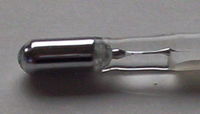
Photo from wikipedia
Abstract N-acetylcysteine (NAC) is antioxidant product that improves its function by scavenges of free oxygen radical and production of reduced glutathione (GSH). It is used in treatment of different inflammatory… Click to show full abstract
Abstract N-acetylcysteine (NAC) is antioxidant product that improves its function by scavenges of free oxygen radical and production of reduced glutathione (GSH). It is used in treatment of different inflammatory diseases and cancers. Subjects and methods 60 male Balb/c mice aged 5–7 weeks old classified into; control (C), two toxin control groups (M6 and M12), NAC control group (S) and two toxin NAC groups SM6 and SM12. From each mouse a blood samples were collected for estimation serum transaminases. Lungs, cardiac, intestinal and splenic homogenates were used for measurement of protein carbonyl content (CC), reduced glutathione, lipid peroxidation products (LPO), protein phosphatase I (PPI) activity, and methylglyoxal (MG). Results Both ALT and AST were showed a significant statistical difference between all groups. In cardiac homogenate both reduced glutathione and methylglyoxal showed significant statistical differences between six groups (P Conclusion Microcystin-LR has cytotoxic effect of different tissue and induces oxidative stress in these tissues. In addition, n-acetylcysteine has antioxidant activity in different tissue by induction of protein phosphatase activity and intracellular level of reduced glutathione.
Journal Title: Journal of King Saud University - Science
Year Published: 2020
Link to full text (if available)
Share on Social Media: Sign Up to like & get
recommendations!